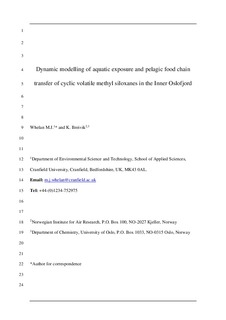| dc.contributor.author | Whelan, M.J. | |
| dc.contributor.author | Breivik, Knut | |
| dc.date.accessioned | 2017-12-04T11:48:55Z | |
| dc.date.available | 2017-12-04T11:48:55Z | |
| dc.date.created | 2013-03-07T08:26:58Z | |
| dc.date.issued | 2013 | |
| dc.identifier.citation | Whelan, M.J., Breivik, K. (2013). Dynamic modelling of aquatic exposure and pelagic food chain transfer of cyclic volatile methyl siloxanes in the Inner Oslofjord. Chemosphere, 93, 794-804. doi:10.1016/j.chemosphere.2012.10.051 | nb_NO |
| dc.identifier.issn | 0045-6535 | |
| dc.identifier.uri | http://hdl.handle.net/11250/2468994 | |
| dc.description.abstract | The marine fate and pelagic food chain transfer of three cyclic volatile methyl siloxanes (cVMS: D4, D5 and D6) was explored in the Inner Oslofjord, Norway, using two dynamic models (the Oslofjord POP Model and the aquatic component of ACC-HUMAN). Predicted concentrations of D4, D5, and D6 in the water column were all less than current analytical detection limits, as was the predicted concentration of D4 in sediment (in agreement with measured data). The concentrations predicted for D5 and D6 in sediment were also in broad agreement with measured concentrations from the Inner Oslofjord. Volatilisation was predicted to be the most important loss mechanism for D5 and D6, whereas hydrolysis was predicted to dominate for D4. Concentrations of all three compounds in sediment are controlled by burial below the active mixed sediment layer. The marine food web model in ACC-HUMAN predicted ‘‘trophic dilution’’ of lipid-normalised cVMS concentrations between zooplankton and herring (Culpea harengus) and between herring and cod (Gadus morhua), principally due to a combination of in-fish metabolism and reduced gut absorption efficiency (as a consequence of high KOW). Predicted D5 concentrations in herring and cod agree well with measured data from the inner fjord, particularly when measured concentrations in zooplankton were used to set the initial dissolved-phase aqueous concentrations. Predicted concentrations of D4 and D6 in fish were over- and under-estimated by the model – possibly due to extrapolation of the metabolism rate constant from D5. | nb_NO |
| dc.language.iso | eng | nb_NO |
| dc.rights | Attribution-NonCommercial-NoDerivatives 4.0 Internasjonal | * |
| dc.rights.uri | http://creativecommons.org/licenses/by-nc-nd/4.0/deed.no | * |
| dc.title | Dynamic modelling of aquatic exposure and pelagic food chain transfer of cyclic volatile methyl siloxanes in the Inner Oslofjord | nb_NO |
| dc.type | Journal article | nb_NO |
| dc.type | Peer reviewed | nb_NO |
| dc.description.version | acceptedVersion | nb_NO |
| dc.rights.holder | © 2012 Elsevier Ltd. All rights reserved. | nb_NO |
| dc.source.pagenumber | 794-804 | nb_NO |
| dc.source.volume | 93 | nb_NO |
| dc.source.journal | Chemosphere | nb_NO |
| dc.source.issue | 5 | nb_NO |
| dc.identifier.doi | 10.1016/j.chemosphere.2012.10.051 | |
| dc.identifier.cristin | 1017572 | |
| dc.relation.project | Norges forskningsråd: 196191 | nb_NO |
| cristin.unitcode | 7460,57,0,0 | |
| cristin.unitname | Atmosfære og klima | |
| cristin.ispublished | true | |
| cristin.fulltext | postprint | |
| cristin.qualitycode | 1 | |

